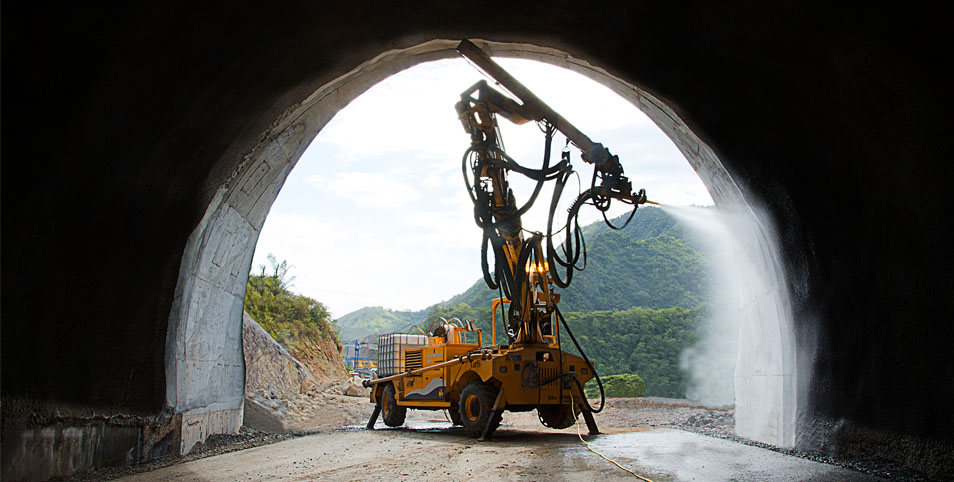Shotcrete, a method of applying concrete or mortar projected at high velocity onto a surface, has become an integral part of modern civil engineering. Its versatility, efficiency, and ability to conform to various shapes make it an invaluable tool in construction projects worldwide. In South Africa, the use of shotcrete has been further enhanced by specialized products like Minecrete, tailored to meet the unique challenges of the region’s construction and mining industries.
Shotcrete in Civil Engineering
Applications
Shotcrete finds extensive use in various civil engineering concrete projects:
- Tunneling: For initial support and final lining
- Slope stabilization: Preventing erosion and rockfalls
- Bridge repair: Restoring structural integrity
- Water infrastructure: Lining canals, dams, and reservoirs
- Building renovation: Strengthening and repairing existing structures
- Underground structures: Constructing basements and parking garages
- Marine structures: Protecting and repairing coastal infrastructure
Advantages in Civil Engineering
- Versatility: Can be applied to various shapes and surfaces
- Reduced formwork: Minimizes or eliminates the need for formwork
- Speed of application: Faster than traditional concrete placement methods
- Structural efficiency: Thinner sections possible due to compaction during application
- Access to difficult areas: Can be applied in areas with limited access
- Bonding: Excellent bonding to properly prepared substrates
- Sustainability: Potential for reduced material waste
Types of Shotcrete
- Dry-mix shotcrete: Dry materials are mixed with water at the nozzle
- Wet-mix shotcrete: Pre-mixed concrete is pumped to the nozzle
Key Considerations in Civil Engineering Applications
- Mix design: Tailored to project requirements (strength, durability, set time)
- Surface preparation: Ensuring proper bonding and performance
- Application technique: Nozzle angle, distance, and movement patterns
- Reinforcement: Use of fiber reinforcement or mesh
- Quality control: Regular testing of strength, thickness, and bond
- Environmental factors: Managing dust, rebound, and water runoff
Minecrete: South African Innovation in Shotcrete
Minecrete is a specialized shotcrete product developed for use in South African mining and civil engineering applications. It addresses specific challenges faced in the region’s construction and mining industries.
Key Features of Minecrete
- Rapid strength development: Achieves high early strength for immediate support
- Durability: Resistant to harsh environmental conditions common in South African mines
- Versatility: Suitable for both underground and surface applications
- Low rebound: Minimizes material waste and improves efficiency
- Custom formulations: Tailored to specific project requirements
Applications of Minecrete in South Africa
- Mining support: Stabilizing tunnels and shafts in deep-level mines
- Slope stabilization: Protecting open-pit mine walls and road cuttings
- Tunnel construction: Used in both mining and civil tunnels
- Water infrastructure: Lining dams and canals in arid regions
- Structural repair: Rehabilitating aging infrastructure
Advantages of Minecrete in the South African Context
- Adapted to local conditions: Formulated to perform in South Africa’s diverse climates
- Cost-effective: Reduces material waste and application time
- Locally produced: Supports South African industry and reduces transportation costs
- Technical support: Local expertise for proper application and troubleshooting
- Proven track record: Extensive use in challenging South African projects
Case Studies: Minecrete in South African Civil Engineering
1. Gautrain Rapid Rail Link
Project: Construction of underground stations and tunnels Application: Minecrete used for initial support and final lining Outcome: Rapid construction progress and excellent durability in variable ground conditions
2. Ingula Pumped Storage Scheme
Project: Construction of underground powerhouse cavern Application: Minecrete applied for rock support and water sealing Outcome: Effective support in high-stress environment and minimal water ingress
3. N2 Wild Coast Road Project
Project: Stabilization of road cuttings in challenging terrain Application: Minecrete used for slope protection and erosion control Outcome: Enhanced slope stability and reduced maintenance requirements
Challenges and Solutions in South African Shotcrete Applications
1. Extreme Weather Conditions
Challenge: Wide temperature variations and intense heat in some regions Solution: Minecrete formulations adjusted for rapid setting and reduced moisture loss
2. Remote Project Locations
Challenge: Difficult access and limited local resources Solution: Mobile batching plants and simplified logistics for Minecrete supply
3. Variable Ground Conditions
Challenge: Diverse geology across project sites Solution: Flexible Minecrete mix designs adaptable to different rock types and groundwater conditions
4. Skills Development
Challenge: Need for skilled shotcrete operators Solution: Comprehensive training programs provided by Minecrete suppliers
Future Trends in Civil Engineering Shotcrete in South Africa
- Sustainability focus: Development of eco-friendly Minecrete formulations using local materials and industrial by-products
- Automation: Introduction of robotic shotcrete application for increased safety and precision
- Advanced admixtures: Incorporation of nanotechnology for enhanced performance
- Digital integration: Use of 3D scanning and BIM for optimized shotcrete application
- Hybrid solutions: Combining Minecrete with other support systems for optimized performance
Best Practices for Minecrete Application in Civil Engineering
- Site assessment: Thorough evaluation of ground conditions and project requirements
- Mix design optimization: Collaboration with Minecrete suppliers for custom formulations
- Equipment maintenance: Regular upkeep of pumps and nozzles for consistent application
- Operator training: Ongoing skill development for shotcrete crews
- Quality control: Implementation of rigorous testing and monitoring protocols
- Safety measures: Dust control, proper ventilation, and use of protective equipment
- Documentation: Detailed record-keeping of mix designs, application methods, and performance data
Conclusion
Shotcrete technology, exemplified by products like Minecrete solutions in South Africa, has revolutionized many aspects of civil engineering construction. Its ability to provide rapid, flexible, and durable solutions makes it an invaluable tool for addressing the unique challenges faced in South African construction projects.
As infrastructure development continues to be a priority in South Africa, the role of specialized shotcrete products like Minecrete is likely to grow. The ongoing innovation in mix designs, application techniques, and quality control measures ensures that shotcrete will remain at the forefront of civil engineering solutions in the country.








